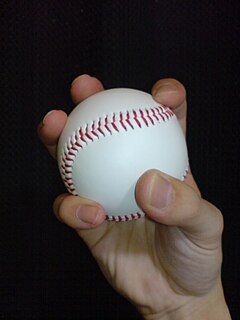 W
WIn baseball, an appeal play occurs when a member of the defensive team calls the attention of an umpire to an infraction which he would otherwise ignore.
 W
WA changeup is a type of pitch in baseball and fastpitch softball. The changeup is the staple off-speed pitch, usually thrown to look like a fastball but arriving much more slowly to the plate. Its reduced speed coupled with its deceptive delivery is meant to confuse the batter's timing. It is meant to be thrown the same as a fastball, but farther back in the hand, which makes it release from the hand slower while still retaining the look of a fastball. A changeup is generally thrown to be 8–15 miles per hour slower than a fastball. If thrown correctly, the changeup will confuse the batter because the human eye cannot discern that the ball is coming significantly slower until it is around 30 feet from the plate. For example, a batter swings at the ball coming at him as if it were a 90 mph fastball, but instead the ball is coming in at 75 mph—this means he will be swinging too early to hit the ball well.
 W
WIn baseball and softball, the curveball is a type of pitch thrown with a characteristic grip and hand movement that imparts forward spin to the ball, causing it to dive as it approaches the plate. Varieties of curveball include the 12–6 curveball, power curveball, and the knuckle curve. Its close relatives are the slider and the slurve. The "curve" of the ball varies from pitcher to pitcher.
 W
WIn baseball, a cut fastball or cutter is a type of fastball that breaks toward the pitcher's glove-hand side, as it reaches home plate. This pitch is somewhere between a slider and a four-seam fastball, as it is usually thrown faster than a slider but with more movement than a typical fastball. Some pitchers use a cutter to prevent hitters from expecting their regular fastballs. A common technique for throwing a cutter is to use a four-seam fastball grip with the baseball set slightly off center in the hand. A batter hitting a cutter pitch often achieves only soft contact and an easy out due to the pitch's movement keeping the ball away from the bat's sweet spot. The cutter is typically 2–5 mph slower than a pitcher's four-seam fastball. In 2010, the average pitch classified as a cutter by PITCHf/x thrown by a right-handed pitcher was 88.6 mph; the average two-seamer was 90.97 mph.
 W
WIn baseball, a double play is the act of making two outs during the same continuous play. The double play is defined in the Official Rules in the Definitions of Terms, and for the official scorer in Rule 9.11. Double plays can occur any time there is at least one baserunner and fewer than two outs.
 W
WThe fastball is the most common type of pitch thrown by pitchers in baseball and softball. "Power pitchers," such as former American major leaguers Nolan Ryan and Roger Clemens, rely on speed to prevent the ball from being hit, and have thrown fastballs at speeds of 95–105 miles per hour (153–169 km/h) (officially) and up to 108.1 miles per hour (174.0 km/h) (unofficially). Pitchers who throw more slowly can put movement on the ball, or throw it on the outside of home plate where batters can't easily reach it.
 W
WIn baseball, a pickoff is an act by a pitcher, throwing a live ball to a fielder so that the fielder can tag out a baserunner who is either leading off or about to begin stealing the next base.
 W
WA rundown, informally known as a pickle or the hotbox, is a situation in the game of baseball that occurs when the baserunner is stranded between two bases, also known as no-man's land, and is in jeopardy of being tagged out. When the base runner attempts to advance to the next base, he is cut off by the defensive player who has a live ball and attempts to return to his previous base before being tagged out. As he is doing this, the defenseman throws the ball past the base runner to the previous base, forcing him to reverse directions again. This is repeated until the runner is put out or reaches a base safely.
 W
WIn baseball, a tag out, sometimes just called a tag, is a play in which a baserunner is out because a fielder touches him with the ball or with the hand or glove holding the ball, while the ball is live and the runner is in jeopardy of being put out – usually when he is not touching a base.
 W
WTie goes to the runner is a popular interpretation of baseball rules. The claim is that a batter-runner who arrives on base the same time as the ball is safe. However, umpires generally reject the concept that baseball provides for a tie in this way, and instead rule on the basis that either the player or the ball has reached the base first.
 W
WIn baseball, an unassisted triple play occurs when a defensive player makes all three outs by himself in one continuous play, without his teammates making any assists. Neal Ball was the first to achieve this in Major League Baseball (MLB) under modern rules, doing so on July 19, 1909. For this rare play to be possible there must be no outs in the inning and at least two runners on base, normally with the runners going on the pitch. An unassisted triple play usually consists of a hard line drive hit directly at an infielder for the first out, with that same fielder then able to double off one of the base runners and tag a second for the second and third outs.